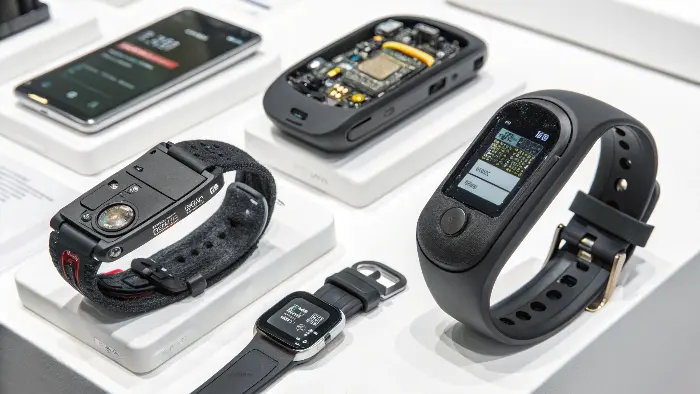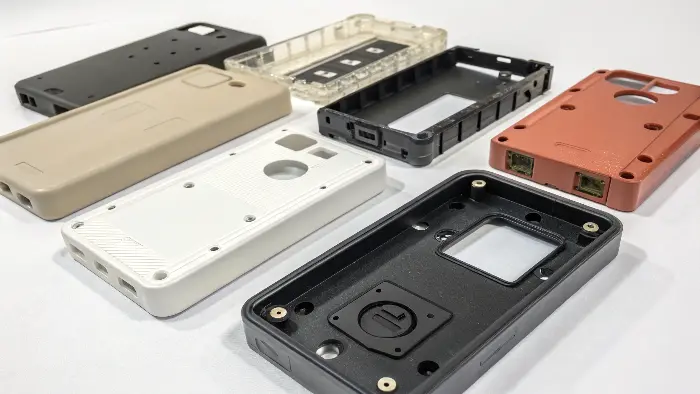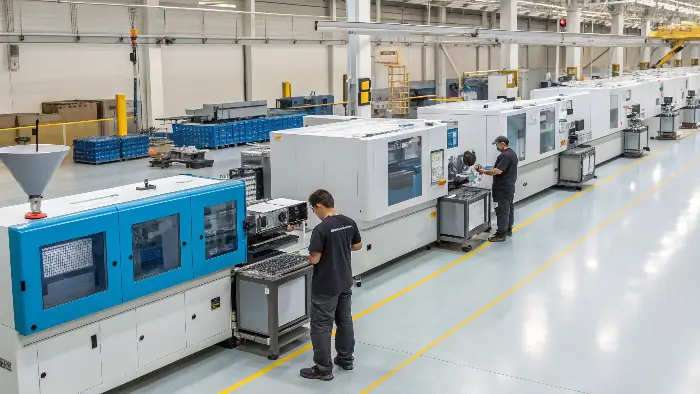Struggling with electronic enclosures that are bulky, costly, or just don’t fit? You need precision and aesthetics, but current methods fall short. Injection molding could be your game-changer.
Injection molding is revolutionizing tech by enabling the mass production of highly precise, complex, and durable electronic enclosures and components. It offers design freedom, material versatility, and cost-effectiveness, which are critical for the fast-paced electronics industry. This means better products, faster.
It sounds pretty good, right? But you might be wondering how all this magic actually happens, and more importantly, how it can specifically benefit your business, especially if you’re dealing with the demands of the tech world like our friend Michael. I’ve spent years in this industry, from working on the factory floor to running my own mold and CNC trading company, and I’ve seen firsthand how powerful this technology is. Let’s dive a bit deeper into what makes injection molding such a powerhouse for electronic applications. We’ve seen it transform businesses, and I want to share some of that with you.
How Does Injection Molding Achieve the Unbelievable Precision Needed for Tiny Electronic Parts?
Tiny electronic parts demand perfection – a micron off can mean failure. Worried your current methods can’t hit that mark consistently for delicate components? It’s a common headache, believe me. Injection molding, though, offers an incredible level of accuracy.
Injection molding achieves incredible precision through meticulously crafted molds, advanced machinery with precise clamping and injection control, and careful material selection. This combination ensures consistent replication of intricate details vital for small electronic parts, down to very tight tolerances. It’s a science, really!
| You know, when I first started in a mold factory, I was blown away by the tolerances we had to hit. For electronic components, we’re talking about features you can barely see with the naked eye! The secret sauce isn’t just one thing; it’s a whole system working together. First, the mold itself – it’s gotta be perfect, no cutting corners here. We use high-grade steel, often hardened, and the cavities are typically machined using super-precise methods like EDM (Electrical Discharge Machining) or high-speed CNC milling. These can achieve incredibly fine details and smooth surface finishes. Then, there’s the injection molding machine. Modern machines are marvels of engineering. They have closed-loop control systems, meaning they constantly monitor and adjust critical parameters like injection pressure, melt temperature, injection speed, and cooling time. This isn’t a "set it and forget it" kind of deal, especially with tiny, intricate parts that need everything to be just so. Material choice also plays a huge role, believe it or not. Different plastics shrink at different rates as they cool, so we have to factor that shrinkage into the mold design itself. It’s a constant balancing act, a real craft. I remember one project for a client, a bit like Michael, who needed a tiny connector housing with super-thin walls. We went through several design tweaks and material tests, minutely adjusting the mold design and process parameters, until we nailed it. It’s this dedication to getting it right – truly mastering the mold and the process – that makes all the difference. This meticulous approach is why we can consistently produce millions of parts that are virtually identical, which is absolutely critical for things like connectors, sensor housings, and those tiny internal supports you never see but are essential for the device to function. |
Factor | Importance for Precision | CKMOLD’s Focus |
|---|---|---|---|
| Mold Design | Paramount | Advanced CAD/CAM simulation, experienced designers, DFM | |
| Mold Manufacturing | Critical | High-precision machining (CNC, EDM), skilled toolmakers | |
| Machine Control | Essential | Modern machines with closed-loop feedback, process monitoring | |
| Material Science | Significant | Careful material selection, deep understanding of shrinkage & flow | |
| Quality Control | Non-negotiable | Rigorous in-process inspection, CMM measurements, batch testing |
Why is Injection Molding So Perfect for Those Crazy Complex Shapes in Modern Electronics?
Modern gadgets are sleek, compact, and full of complex curves, undercuts, and internal features. Are you finding it tough, maybe even impossible, to manufacture these intricate designs effectively with your current methods? Injection molding thrives on complexity, making those ambitious designs a reality.
Injection molding excels at producing complex shapes because molten plastic can flow into and fill intricate mold cavities under high pressure. This allows for integrated features like ribs, bosses, snap-fits, living hinges, and varying wall thicknesses, all in a single part, drastically reducing assembly needs.

I’ve seen product designs evolve so much over my years in the business! Back in the day, many electronics were, let’s be honest, a bit boxy and utilitarian. Now? It’s all about smooth lines, ergonomic shapes, and packing more and more technology into smaller and smaller spaces. This is where injection molding really flexes its muscles – seriously, it’s a game-changer for designers. Think about the casing for your smartphone, your wireless earbuds, or the housing for a smart home device. They often have these incredibly complex internal structures to hold circuit boards, batteries, antennas, and buttons, plus all the external curves and details that make them look and feel good.
Trying to make those parts with other methods, like machining them from a solid block or fabricating them from sheet metal, would be a nightmare for mass production. You’d be looking at multiple individual pieces, tons of assembly labor, higher costs, and potentially more points of failure. But with injection molding, we can design a mold that creates all those features – internal ribs for strength, bosses for screws, snap-fit closures, light pipes, even overmolded soft-touch grips – in one single shot. We use clever mold engineering techniques like slides, lifters, and collapsing cores. These are moving components within the mold that create undercuts and internal details that wouldn’t be possible with a simple open-and-shut mold. It’s like a little mechanical ballet happening inside the machine with each cycle! For a client, say someone like Michael who’s developing a new wearable fitness tracker, this capability is pure gold. They can design for optimal function and aesthetics without being overly constrained by manufacturing limitations. We once helped a company that was struggling to combine three separate, fiddly parts into one elegant housing for a new handheld medical scanner. Injection molding allowed us to integrate all the features, which simplified their assembly line, reduced their overall costs, and even made the final product stronger and more reliable. That’s the kind of problem-solving I absolutely love about this work! It’s not just about making plastic parts; it’s about enabling innovation and making better products.
What Materials Make Injection Molded Electronics Casings So Tough and Versatile?
| Electronic devices need to be more than just pretty; they need to be durable, sometimes heat resistant, or even provide electromagnetic interference (EMI) shielding. Feeling limited by material choices for your enclosures or components? Injection molding offers a vast, and I mean vast, palette of high-performance plastics. A wide range of engineering thermoplastics makes injection molded electronics casings tough and versatile. Materials like ABS offer excellent impact resistance and aesthetics, Polycarbonate provides superior strength and clarity, while specialized polymers like PEEK can handle extreme temperatures. Additives can also provide EMI shielding or flame retardancy.  Choosing the right material is absolutely key, especially in the demanding world of electronics. It’s not just about how the part looks or feels in your hand; it’s about long-term performance, safety, and often, regulatory compliance. I always tell my clients, like Michael, to really think about the entire lifecycle and environment of their device. Is it a consumer gadget that needs to survive a few accidental drops from the coffee table? Then something like ABS (Acrylonitrile Butadiene Styrene) or PC (Polycarbonate), or even a PC/ABS blend, offers a great balance of impact resistance, stiffness, and finish. I remember a customer who was making ruggedized tablets for construction workers – PC/ABS was a lifesaver for them, literally making their product tough enough for the job site. What if the device generates significant internal heat, or it’s designed to operate in a hot environment, say, under the hood of a car or in industrial machinery? Then we might look at engineering plastics like PBT (Polybutylene Terephthalate), Nylon (PA), or even high-performance thermoplastics like PPS (Polyphenylene Sulfide) or PEEK (Polyether Ether Ketone), though PEEK is on the pricier side, it’s incredible stuff for extreme conditions. Flame retardancy is another big one, often a non-negotiable requirement for safety certifications like UL. Many plastics can be formulated with flame-retardant additives to meet these standards – it’s a must for anything plugged into the wall or containing batteries. And let’s not forget EMI/RFI shielding! With all the wireless signals flying around today, you don’t want your device interfering with others, or being susceptible to interference itself. We can use plastics compounded with conductive fillers (like carbon fibers or stainless steel fibers) or apply conductive coatings or plating after molding. It’s amazing how much chemistry and material science goes into selecting the right "plastic." It’s not just one material; it’s a whole universe of options, each with its own unique set of properties. We work closely with clients to understand their specific application needs – Is it for a sleek consumer product where aesthetics are paramount, or a rugged industrial controller where durability is king? – and then guide them to the optimal material. It’s an integral part of mastering the whole molding process, ensuring the final part does exactly what it needs to do. |
Material Category | Common Examples | Key Properties for Electronics | Typical Applications in Tech |
|---|---|---|---|---|
| Amorphous Commodity | PS, SAN | Good clarity (PS), decent stiffness, low cost | Disposable items, simple internal trays | |
| Crystalline Commodity | PP, PE | Excellent chemical resistance, low cost, good fatigue resistance | Battery casings, living hinges, wire insulation | |
| Amorphous Engineering | PC, ABS, PMMA, PETG | High impact strength (PC, ABS), optical clarity (PMMA, PC, PETG) | Enclosures, lenses, light pipes, display covers | |
| Crystalline Engineering | Nylon (PA), PBT, POM | Good wear resistance, chemical resistance, heat resistance | Gears, bearings, connectors, automotive components | |
| High-Performance | PEEK, PPSU, PEI, LCP | Extreme heat resistance, chemical inertness, high strength, V0 | Medical devices, aerospace, downhole, demanding IC sockets | |
| Blends/Alloys | PC/ABS, PC/PBT | Combines properties (e.g., toughness of ABS + strength of PC) | Ruggedized enclosures, automotive dashboards |
Can Injection Molding Really Slash Costs and Scale Up Production for My Tech Gadgets?
Bringing new tech products to market is an expensive endeavor, and production bottlenecks can absolutely kill your momentum and profitability. Are you constantly wondering if there’s a more efficient way to make high-quality parts affordably and at the massive scale the tech market often demands? Injection molding is very often the answer.
Yes, injection molding dramatically slashes per-part costs and enables massive scalability by facilitating high-speed, automated manufacturing of identical parts once the initial mold investment is covered. While mold tooling requires an upfront cost, the per-part cost becomes exceptionally low in high-volume production, making it ideal for mass-produced tech gadgets.

This is a huge consideration for any business owner, especially someone like Michael who’s running a manufacturing company and needs to keep a sharp eye on the bottom line while ensuring product availability. So, let’s talk frankly about money and speed. The initial mold – yes, that’s an investment. And good, high-cavitation, hardened steel molds aren’t cheap because they’re incredibly complex, precision-engineered tools designed to last for hundreds of thousands, or even millions, of cycles. I’ve seen businesses hesitate at this upfront cost.
But here’s the kicker, and it’s a big one: once that mold is built, tested, and dialed into the production machine, you can churn out parts incredibly fast. Cycle times can range from a few seconds to a minute or so, depending on the part size and complexity. And because the process is largely automated – plastic pellets go in one end, finished parts come out the other, often handled by robotics – labor costs per part are minimal. I’ve seen vast molding floors where a handful of skilled technicians oversee a whole battery of machines running 24/7. Just imagine that for a moment – you could be producing thousands, even tens of thousands, of your electronic enclosures or components every single day. For a new consumer electronic device that’s expected to sell in high volumes, that kind of scalability is not just beneficial, it’s absolutely crucial. If your product suddenly takes off (the dream, right?), you need to be able to meet that surging demand, fast. Trying to do that with slower, more labor-intensive methods would be a disaster.
And the consistency is amazing. Part number one million will be virtually identical to part number one, thanks to the fixed nature of the mold cavity and the precise control of the molding process. This drastically reduces waste, simplifies quality control, and ensures that your product assembles smoothly every time. Compare this to, say, CNC machining every single enclosure. The per-part cost would be significantly higher, and the production speed much, much slower for true mass production volumes. So, while that upfront mold cost might seem daunting, if you’re planning for any significant volume, injection molding almost always wins on the total cost of ownership and speed to market at scale. It’s about looking at the bigger picture, the entire lifecycle cost, and that’s something we always try to help our clients at CKMOLD understand. That initial investment in good tooling pays for itself many times over by enabling efficient, high-volume production. It’s a fundamental enabler for growth and market leadership in the tech industry.
Conclusion
So, injection molding is pretty much a tech industry superhero! It delivers the precision, complex designs, robust materials, and cost-effective scaling essential for today’s electronics. It’s how great electronic products get made efficiently and reliably. CKMOLD is here to share the knowledge to help you master it.
